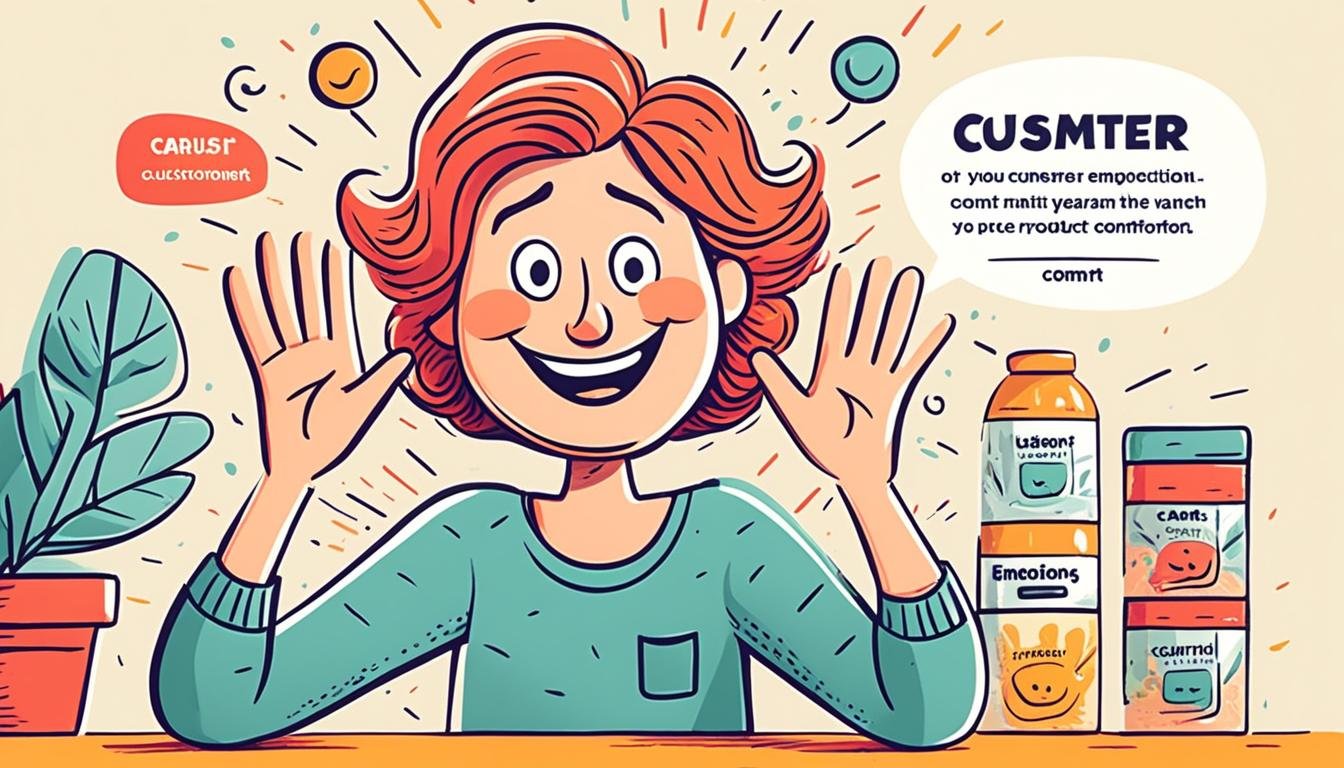Emotional Marketing: Connecting with customers on an emotional level.
Did you know ads that make you feel something are more powerful? The Advertising Research Foundation found emotional marketing can make people twice as likely to engage and buy. A big bank saw a 40% increase in new customers with a credit card campaign aimed at Millennials. This shows how emotional connection in marketing can really change the game.
Emotional marketing is more than just ads. It uses feelings to build strong loyalty and engagement. By connecting with people on a personal level, it leads to more loyal customers, higher lifetime value, and better brand recognition. It also boosts emotional appeal in advertising and grows valuable customer segments across the company.
Brands like Coca-Cola, Dove, and Nike know how to touch people’s hearts. Nike’s “Dream Crazy” campaign with Colin Kaepernick boosted online sales by 31%. Dove’s Real Beauty campaign saw sales jump 700% in just two months. These stories show how emotional marketing builds strong connections and drives success.
Key Takeaways
- Advertisements eliciting an emotional response are more effective than informational ones.
- Emotional marketing drives higher customer engagement and purchasing behavior.
- Campaigns from brands like Nike, Coca-Cola, and Dove show the power of emotional connections.
- Emotional appeal in advertising increases customer loyalty and brand recognition.
- Emotional marketing impacts all organizational functions and not just marketing.
Understanding Emotional Marketing
Emotional marketing uses strong feelings like joy and nostalgia to connect with customers. It makes a big impact on how people see and choose brands. By tapping into emotions, brands can tell stories that really speak to people.
Definition and Importance
Emotional marketing is about using feelings to connect with consumers. It’s very important:
- After a major bank introduced a credit card for Millennials designed to inspire emotional connection, usage among this segment skyrocketed by 70%, with new account growth climbing 40%.
- A leading household cleaner achieved double-digit growth within a year by shifting its products and messaging to maximize emotional connection.
- A nationwide apparel retailer saw same-store sales growth accelerate more than threefold by reorienting its strategies toward its most emotionally connected customer segments.
Emotional Motivators
Harvard Business Review found nearly 300 emotional motivators linked to buying behavior. Brands focus on 2-3 key motivators that match their brand. These include:
- Fear of Missing Out (FOMO): Creates urgency and pushes consumers towards timely purchasing decisions.
- Nostalgia: Leverages culturally connected feelings to evoke pleasant memories and a sense of comfort.
- Joy: Highlights positive experiences and the aspirational use of products to enhance life fulfillment.
Using powerful images and secondary emotions helps evoke these motivators. Building trust through reviews and personalized messages is key to emotional marketing. When people feel a bond with a brand, they become more loyal and satisfied, which helps the brand do well over time.
Benefits of Emotional Marketing
Using emotional marketing in your business can bring big wins. It helps your brand grow and succeed.
Building Stronger Connections
Emotional marketing helps brands connect deeply with people. It makes brands feel like friends, not just sellers. For example, ads that touch our feelings can boost sales by 23%, says Nielsen.
Half of what we buy is because of how we feel, not just what we need. So, ads that touch our hearts can really change how we act.
Enhancing Brand Loyalty
Emotional marketing builds strong customer loyalty. When people feel a bond with a brand, they stick around and even spread the word. This loyalty comes from the emotional ties made by marketing that speaks to the heart.
Studies show that feeling a connection with a brand is worth 52% more than just being happy with it. Big names like Apple and Google use emotional branding to keep customers coming back.
Driving Customer Engagement
Customers who feel engaged tell their stories and share their experiences. This word-of-mouth helps brands grow naturally. Emotional marketing gets people to feel something real about a brand.
People often remember ads more for how they made them feel than what they said. This can make ads go viral. Going viral means more people see the brand, buy more, and get involved.
Overall, emotional marketing makes customers stick around and get more involved. This creates a cycle that’s good for both the brand and its customers.
Crafting Compelling Brand Stories
Storytelling is key in emotional marketing because people love stories. Brands can connect with their audience by sharing stories that match their values and experiences. This makes the brand seem real and true, which is very powerful.
Stories that touch on emotions help brands stand out. They create a bond with customers and make the brand’s message memorable.
Studies show that brands that touch customers on an emotional level get noticed more. This leads to more people knowing about the brand.
Stories that make people feel something can make customers more engaged. This means they stick with the brand more. Brands like Nike, Apple, and Starbucks use stories to connect with people, making them more loyal.
Sharing stories on different platforms helps brands build a strong bond with their audience. This includes websites, ads, and social media.
A true brand story makes a brand seem more real and trustworthy. It helps build stronger relationships with customers. Here are some tips for a great brand story:
- Know what your audience values and goes through.
- Show you’re real and true.
- Use stories with relatable characters and themes.
- Keep your story the same everywhere you share it.
- Use stories from real customers to back up your brand.
Warby Parker is a great example of how storytelling in marketing works. By telling a compelling story, they’ve made a mark in a crowded market. This approach builds deep connections with customers, leading to loyalty and lasting relationships.
Emotional Branding Techniques
Effective emotional branding uses stories and visuals to connect with people. It taps into emotions to build stronger bonds with the audience.
Storytelling and Narrative Creation
Storytelling is key in emotional branding. It uses stories that touch on people’s dreams and struggles. Brands like Patagonia and Google use stories to connect with their audience.
Patagonia stands out for its environmental commitment. Google shares big moments from the year, building emotional ties with people.
Humans love stories. Using stories in marketing helps brands connect deeply with customers. This makes their message stick in people’s minds.
Visual and Video Content
Visuals and videos are crucial for emotional branding. Since humans see images much faster than text, they boost emotional impact. The Always #LikeAGirl campaign, for instance, used visuals to challenge gender stereotypes and won awards.
GEICO used humor and visuals to become a top insurance company. These tactics create engaging content that builds strong connections with the audience.
Identifying and Understanding Customer Emotions
Understanding what your customers feel is key to emotional marketing success. By analyzing customer emotions, brands can see what motivates people to buy. Tools like market surveys and social listening help uncover emotional drivers. This way, brands can make campaigns that speak to different customers.
Customer personas are vital for this approach. They reveal what customers need and want. This knowledge helps improve how customers see the brand. Studies show that emotionally connected customers spend twice as much as those who are just satisfied. Also, those with a strong bond with a brand are 52% more valuable.
Using omnichannel analytics platforms helps analyze customer emotions fully. This method combines data from many sources to grasp the emotional bond with the brand. Insights from this data can greatly improve marketing and engage customers better. For example, unhappy customers are 30% less likely to buy again, but happy ones are 93% likely to return.
Emotions often lead customer decisions, not logic. Fears and desires play big roles in what people buy. Campaigns that tap into these feelings can boost brand loyalty and sales. The Qualtrics XM Institute found that positive experiences make customers 4.2 times more trusting and 3.5 times more likely to buy again. So, knowing and meeting customer emotions is key to better sales and loyal customers.
Using Evocative Visuals and Imagery
Visuals in marketing have a huge emotional impact. They can quickly share feelings and set the mood. Knowing how colors work in branding can boost your marketing a lot.
Impact of Visuals on Emotions
Visuals are key in emotional marketing. They can make people feel happy, nostalgic, or peaceful. Studies show that people often buy things because of how they feel about the pictures, not just the facts.
This shows how important visuals are for making people remember and stick with a brand. By picking the right visuals, brands can make experiences that match what their audience likes and hopes for.
Design and Color Psychology
Color psychology is big in branding. Different colors make people feel different things: bright reds make people excited, while soft blues make them feel calm and trust you. Marketers should use this to their advantage.
Choosing colors that match the feeling you want to create can make your campaigns more engaging and emotionally deep. Using design and color smartly can make a stronger bond with customers, increase loyalty, and get people more involved.
- Red: Evokes excitement, passion, and urgency.
- Blue: Represents calm, trust, and professionalism.
- Yellow: Conveys happiness, energy, and attention-grabbing.
- Green: Symbolizes growth, health, and tranquility.
- Purple: Signifies luxury, creativity, and wisdom.
In the end, using visuals and color smartly can deeply affect how consumers feel and act. This makes it a vital part of emotional marketing.
Emotional Storytelling in Marketing
Emotional storytelling in marketing uses the power of stories to connect with people. It makes customers feel something, which helps brands stand out. By sharing real stories, brands show what they believe in and build strong bonds with their audience.
Brands that tell emotional stories often see more loyal customers, happier customers, and more sales. These stories make a lasting impression, creating a memorable experience for the audience.
Here are the main benefits of using stories in your marketing:
- Higher Customer Engagement: Emotional stories grab the audience’s feelings, leading to more interaction. People love to share stories that touch their hearts.
- Building Trust and Credibility: Real stories build trust with customers. Studies show that emotional ads can make 70% of viewers want to buy a product.
- Brand Differentiation: Emotional stories set a brand apart from others. They create a unique image that grabs attention in a crowded market.
Let’s look at some stats that show how powerful emotional storytelling is:
71% of customers recommend a brand if they feel a strong emotional bond with it. This shows how big an impact emotional stories can have on loyalty.
In summary, using emotional storytelling in marketing helps build stronger customer relationships, boosts engagement, and drives sales. By telling stories that touch people’s hearts, brands can turn customers into loyal fans, leading to long-term success.
Leveraging Big Data Analytics for Emotional Marketing
In today’s market, using big data in marketing is key for deep emotional connections. By looking at lots of data, marketers find important patterns. These patterns help them connect with customers on an emotional level.
Identifying Key Emotional Motivators
Big data helps businesses find what moves customers emotionally. There are 223 emotional triggers out there. Self-image and social image are big ones, shaping how people make choices.
Companies like Netflix, Amazon, and Starbucks use this knowledge well. They make their marketing hit closer to home with their audience.
Tailoring Strategies to High-Value Segments
Using big data, marketers can sort their audience by what moves them emotionally. This leads to campaigns that work way better, up to 20 times more. By focusing on key groups, businesses can make their marketing more effective.
This smart use of big data not only saves resources but also makes marketing better. It helps in building strong customer loyalty and engagement.
Psychological Marketing Approach
The psychological marketing approach looks into how emotions affect what we buy. It focuses on making a deep bond between brands and people by tapping into feelings. Studies show that emotions play a big role in our choices, not just facts.
This method aims to understand what drives us to pick certain products. It shows that our feelings come into play faster than our logical thoughts. For example, Coca-Cola’s “Choose Happiness” campaign makes people feel happy and fulfilled.
Feelings like fear, guilt, and love push us to make choices. Brands that touch these feelings often see more sales. Burger King’s “Whopper Detour” campaign made people feel something, connecting with them instantly.
Good emotional marketing also gets people talking and builds loyalty. The Lego “Rebuild the World” campaign used stories to make people feel hopeful. This kind of marketing builds a strong emotional link with customers, making them more loyal.
Knowing how emotions work is key to making a mark with marketing. Antonio Damasio’s book “Descartes’ Error” highlights how emotions guide our decisions. By using this knowledge, marketers can create campaigns that really speak to people, building lasting connections and success.
Conclusion
Understanding and tapping into customers’ emotions is key to building strong brand connections. Emotional marketing offers many benefits, like making customers more loyal and engaged. By using emotional strategies, companies can create memorable campaigns that touch on feelings like joy and sadness.
Emotional marketing helps attract and keep customers by making products or services more appealing. It uses emotions to grab attention, get people talking, and drive sales. Being real in emotional marketing builds trust and keeps credibility high. When brands connect deeply with customers, they can change how people buy things and build a loyal customer base.
Using emotional marketing can make a big difference in business success. It works well in many places, like stores, online, social media, and customer service. By telling stories, creating empathetic content, and using data for insights, brands can really connect with people. Using nostalgia and other emotions in marketing helps keep customers interested and builds stronger bonds with the brand.
Source Links
- Use Emotional Marketing to Grow Your Business
- Connecting with Your Customers: The Power of Emotional Marketing
- The New Science of Customer Emotions
- What is emotional marketing?
- Why emotional marketing works (and how you can do it, too) – REC Media
- The advantages of emotional marketing – Generaxion
- Emotional marketing: why it’s so effective and how to use it (+ examples)
- Crafting Compelling Brand Stories: A Key to Successful Marketing
- Crafting Compelling Brand Stories: The Art of Brand Storytelling
- Crafting Compelling Brand Stories in Digital Marketing
- Emotional Branding: What It Is and How to Use It Effectively – crowdspring Blog
- What is Emotional Branding and How to Use it Effectively
- What is customer emotion?
- Addressing Customer Emotions in Your Sales Strategy
- The Power of Emotional Marketing: Connecting with Audiences
- Emotional Marketing: The Power of Authentic Connections | Mailchimp
- The Power of Emotional Marketing: Connecting with Customers on an Emotional Level
- The Power of Emotion in B2B Marketing: Creating Content that Converts
- The Power of Emotional Storytelling in Your Marketing Strategy
- How to leverage emotional storytelling for brand engagement
- Emotional Marketing 101: How To Leverage The Power of Emotions for Conversion Rate Optimization
- Contents
- Data-Driven Marketing: Leveraging Analytics to Make Informed Decisions
- The Psychology of Emotional Marketing | Gemius Marketing Blogs
- Your Primer to the Psychology of Marketing and Emotional Buying | BigCommerce
- Emotional Marketing: Great Tactic to Build Customer Relationships
- The Ultimate Guide to Emotional Marketing – Marrina Decisions





